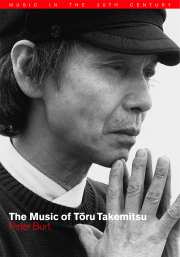Book contents
- Frontmatter
- Contents
- Acknowledgements
- Note on conventions
- Introduction
- 1 Pre-history: how Western music came to Japan
- 2 Music and ‘pre-music’: Takemitsu's early years
- 3 Experimental workshop: the years of Jikken Kōbō
- 4 The Requiem and its reception
- 5 Projections on to a Western mirror
- 6 ‘Cage shock’ and after
- 7 Projections on to an Eastern mirror
- 8 Modernist apogee: the early 1970s
- 9 Descent into the pentagonal garden
- 10 Towards the sea of tonality: the works of the 1980s
- 11 Beyond the far calls: the final years
- 12 Swimming in the ocean that has no West or East
- Notes
- List of Takemitsu's Works
- Select bibliography
- Index
7 - Projections on to an Eastern mirror
Published online by Cambridge University Press: 18 August 2009
- Frontmatter
- Contents
- Acknowledgements
- Note on conventions
- Introduction
- 1 Pre-history: how Western music came to Japan
- 2 Music and ‘pre-music’: Takemitsu's early years
- 3 Experimental workshop: the years of Jikken Kōbō
- 4 The Requiem and its reception
- 5 Projections on to a Western mirror
- 6 ‘Cage shock’ and after
- 7 Projections on to an Eastern mirror
- 8 Modernist apogee: the early 1970s
- 9 Descent into the pentagonal garden
- 10 Towards the sea of tonality: the works of the 1980s
- 11 Beyond the far calls: the final years
- 12 Swimming in the ocean that has no West or East
- Notes
- List of Takemitsu's Works
- Select bibliography
- Index
Summary
Of all the effects the encounter with Cage had upon Takemitsu's musical thinking, perhaps the most significant was that of reconciling him at last to his own native musical tradition. As we have seen, Takemitsu claimed that at the outset he had ‘struggled to avoid being “Japanese”, to avoid “Japanese”qualities’; now, however, ‘largely through my contact with John Cage’ he was able ‘to recognise the value of my own tradition’. But despite these claims it is clear that Takemitsu had already become deeply interested in traditional Japanese music before Cage's appearance on the scene. In particular, a passage in Mirror of Tree, Mirror of Grass describes the moment in which he first recognised the intrinsic qualities of his own music in similarly epiphanic terms to those he used to describe his encounter with the music of Lucienne Boyer some years previously: ‘It was ten years after I began studying music that I received a strong shock from a bunraku performance. It was then that I became aware of Japan for the first time. In fact I saw Japan represented as distinct from myself, and acknowledged it as entirely different.’
Takemitsu does not give an exact date for this revelation: Miyamoto supposes it to have occurred around 1958, which was certainly ‘ten years after’ Takemitsu ‘began studying music’ in the official sense of taking lessons with Kiyose. At all events, Takemitsu's ‘Japanese shock’ clearly predated his ‘Cage shock’ by a number of years, and as we have already seen, specifically ‘Japanese’ musical ideas are referred to in Takemitsu's programme notes at least as early as his references to the ‘one by one’ rhythm of Requiem (1957) or to the nō theatre in Masque (1959).
- Type
- Chapter
- Information
- The Music of Toru Takemitsu , pp. 110 - 131Publisher: Cambridge University PressPrint publication year: 2001

